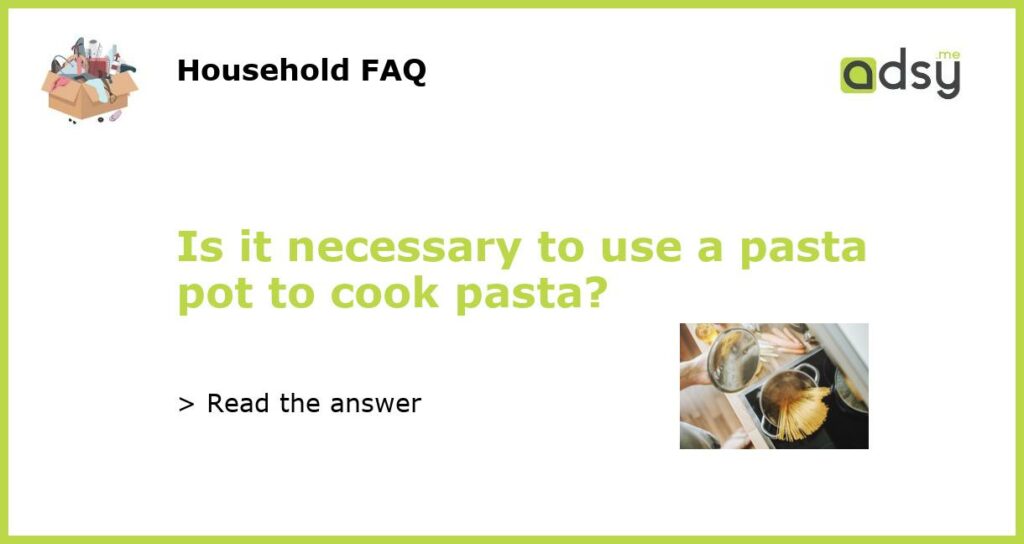Using a Pasta Pot: Is it Essential for Cooking Pasta?
When it comes to cooking pasta, many people swear by using a pasta pot. This specialized pot is designed with several features that are said to make cooking pasta easier and more efficient. But is it really necessary to use a pasta pot to cook pasta? In this article, we will explore the advantages and disadvantages of using a pasta pot and whether or not it is essential for cooking pasta.
The Advantages of Using a Pasta Pot
1. Built-in Strainer: One of the main advantages of using a pasta pot is the built-in strainer. Most pasta pots feature a removable strainer basket or colander that fits inside the pot. This allows you to easily drain the pasta without having to use a separate colander or strainer, saving you time and effort.
2. Even Cooking: Another advantage of using a pasta pot is the design of the pot itself. Pasta pots are typically tall and narrow, which helps to ensure even cooking of the pasta. The narrow shape of the pot allows the water to come to a boil more quickly and maintain a consistent temperature throughout the cooking process.
3. Easy Storage: Pasta pots are also designed with space-saving in mind. Many pasta pots come with a locking lid that can be used to store the pot and strainer together. This can be especially helpful for those with limited kitchen storage space.
The Disadvantages of Using a Pasta Pot
1. Limited Capacity: One of the main disadvantages of using a pasta pot is its limited capacity. Pasta pots are typically smaller in size compared to regular pots, which means you may need to cook pasta in smaller batches if you are preparing a large meal.
2. Extra Cost: Another disadvantage of using a pasta pot is the additional cost. Pasta pots are a specialized kitchen item and can be more expensive than regular pots. If you are on a tight budget or limited kitchen space, investing in a pasta pot may not be practical.
3. Extra Cleaning: Using a pasta pot also means you have an extra pot to clean. While the built-in strainer may save you time when draining the pasta, it still requires cleaning after use. If you already have a colander or strainer that you regularly use for other cooking purposes, using a separate pot may just add to your cleaning tasks.
Is a Pasta Pot Essential for Cooking Pasta?
In conclusion, while using a pasta pot can offer certain advantages such as a built-in strainer, even cooking, and easy storage, it is not essential for cooking pasta. You can still achieve perfectly cooked pasta using a regular pot and a separate colander or strainer. The decision to use a pasta pot ultimately depends on your personal preferences, kitchen space, and budget constraints.
Alternatives to Using a Pasta Pot
If you decide that a pasta pot is not necessary for you, there are a few alternatives you can consider:
1. Regular Pot and Colander: The most common alternative to using a pasta pot is to cook the pasta in a regular pot and then use a colander or strainer to drain it. This method may take a bit more effort, but it is just as effective in cooking pasta.
2. One-Pot Pasta Recipes: Another option is to explore one-pot pasta recipes. These recipes involve cooking the pasta along with the sauce and other ingredients in the same pot, eliminating the need for a separate strainer. This can be a convenient and time-saving option.
3. Electric Pasta Cookers: If you frequently cook pasta and want a dedicated appliance, you can consider investing in an electric pasta cooker. These appliances are designed specifically for cooking pasta and often have built-in strainers or draining mechanisms.
In the end, the choice of whether or not to use a pasta pot is up to you. Consider your cooking style, kitchen space, and budget before making a decision. Whether you choose to use a pasta pot or not, what matters most is that you enjoy a delicious plate of perfectly cooked pasta.






